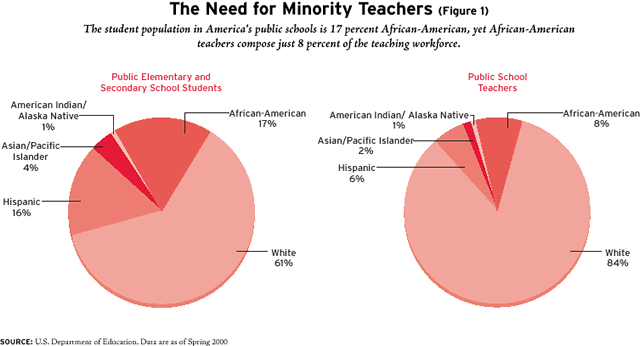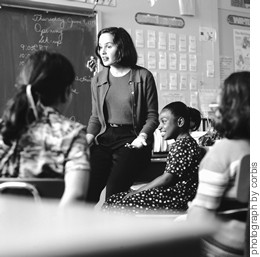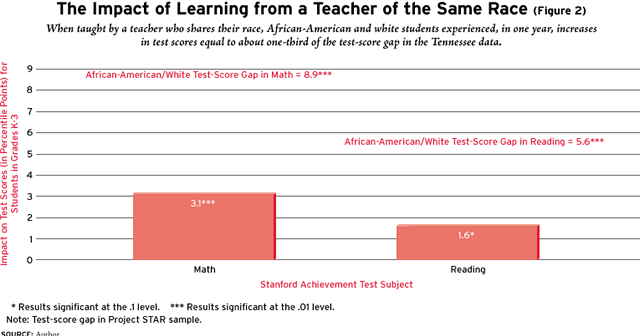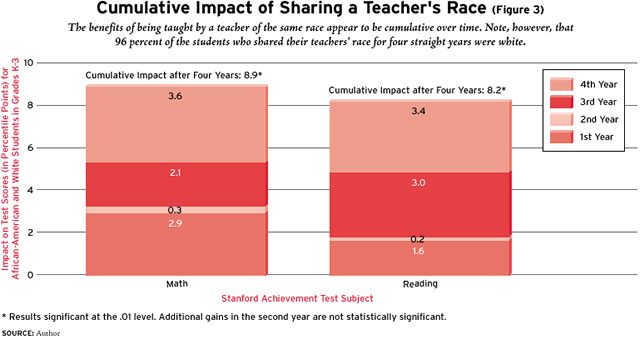 In the mid-1960s, an acquaintance of mine was a young, timid teacher beginning her career in a virtually all-black high school on the South Side of Chicago. Even to this day, she recalls two events from that period. On one occasion, she saw a burly white male teacher telling a group of black teenagers that they were stupid and that they had better realize it. On another occasion, she observed as a classroom of unruly adolescents was silenced by the fixed stare of a black female teacher, whose disciplinary approach surely reminded many of their mothers at home.
In the mid-1960s, an acquaintance of mine was a young, timid teacher beginning her career in a virtually all-black high school on the South Side of Chicago. Even to this day, she recalls two events from that period. On one occasion, she saw a burly white male teacher telling a group of black teenagers that they were stupid and that they had better realize it. On another occasion, she observed as a classroom of unruly adolescents was silenced by the fixed stare of a black female teacher, whose disciplinary approach surely reminded many of their mothers at home.
The contrast between these two teachers, while more extreme than one usually finds, either then or now, nevertheless helps to explain why so many are urging the nation to recruit more minority teachers. The availability of minority teachers appears to be an important issue. While 17 percent of the students in K-12 public schools are black, black teachers make up just 8 percent of the teaching force (see Figure 1). These disparities are even more pronounced in many urban schools, where student bodies that are nearly 100 percent minority are often taught by majority-white teaching staffs.
However, we actually know very little about how differences between a teacher’s race and those of her students affect the learning environment. This study makes use of data from a randomized field trial conducted in Tennessee to produce higher-quality information on this controversial subject than has been available previously. The results are troubling. Black students learn more from black teachers and white students from white teachers, suggesting that the racial dynamics within classrooms may contribute to the persistent racial gap in student performance, at least in Tennessee.

Why Race Could Matter
The racial interactions between teachers and students could influence student performance in several ways. For example, pupils may trust and respect someone with whom they share a salient characteristic, making learning come more easily. Likewise, a teacher of the same race may serve as a more effective role model, boosting students’ confidence and enthusiasm for learning. However, while such role-model effects are widely believed to be important, there is actually little direct empirical evidence that they exist.
Claude M. Steele’s theory of “stereotype threat” suggests another way that student performance might respond to a teacher’s race (and one for which there is empirical support). Stereotype threat can occur in situations where students perceive that a stereotype regarding their ability will come into play-such as when a black student is taught by a white teacher.
A series of experiments conducted at Stanford University by Steele and Joshua Aronson appear to confirm the existence of the stereotype threat phenomenon. Groups of students took tests comprising the most difficult items on the verbal GRE exam. When told beforehand that the test was a laboratory problem-solving task unrelated to ability, black and white students performed similarly. However, black students performed relatively worse when told that the test was diagnostic of ability. The racial differences were similar when researchers merely asked students to fill out a pretest demographic questionnaire that inquired into their race, a minor manipulation of the stereotype threat.
There may also be (largely unintended) racial biases in teachers’ behavior. In particular, minority teachers may be more generous with minority students, devoting more time to them and making more favorable assumptions about their capabilities. White teachers may be relatively generous with white students in just the same ways. A limited body of experimental evidence does suggest that teachers, in allocating class time, interacting with students, and designing class materials, are more favorably disposed toward students who share their racial or ethnic background. For example, a 1979 study by Marylee Taylor placed white teachers in a teaching environment where they could not observe the student directly. Taylor found that the teachers provided less coaching and briefer, less positive feedback when told beforehand that the student was black. Similarly, studies based on observations from actual classrooms often find that black students with white teachers receive less attention, are praised less, and are scolded more often than their white counterparts.
However, there is surprisingly little empirical evidence on the relationship between students’ exposure to teachers of their own race and their subsequent academic performance. And the available studies, all of which rely on observational data to compare the test scores of students with different kinds of teachers, actually find that having a teacher of the same race has little impact. However, the inferences based on conventional data sets could be quite misleading. For example, if lower-performing black students are more likely to be assigned to black teachers, the effects of such teachers will be underestimated.
 |
| Minority teachers may be more generous with minority students, devoting more time to them and making more favorable assumptions about their capabilities. White teachers may be relatively generous with white students in just the same ways.
|
Project STAR
This study presents new evidence on the test-score consequences of a teacher’s race by examining data from Tennessee’s well-known experiment in reducing class size, Project STAR (Student Teacher Achievement Ratio). A key feature of Project STAR’s experimental design was the random assignment of both students and teachers to specific classrooms within each school. Project STAR was not designed to evaluate the relationship between students’ performance and their assignment to teachers of their own race. Nonetheless, the study’s randomized pairings of students and teachers provide an excellent opportunity to do so.
Project STAR followed a cohort of students from 79 schools as they progressed from kindergarten through 3rd grade. Within each school, students and teachers were assigned randomly to classrooms of three types: a small class of 15 students and two regular-sized classes of 22 students (one with a teacher’s aide). Started in 1985 with 6,325 kindergartners, the study ultimately came to include roughly 11,600 students, with 2,200, 1,600, and 1,200 students entering in the 1st, 2nd, and 3rd grades, respectively. Students were administered the Stanford Achievement Tests in math and reading in the spring of each study year.
Given Project STAR’s limited number of Hispanic, Asian, and Native American participants, I edited these data to include only those observations from black and white non-Hispanic students with black and white non-Hispanic teachers. This process excluded just 95 students from the original 6,325 kindergartners. A small number of students with missing test scores or other data were also excluded.
Overall, roughly two-thirds of the students in the remaining sample were white. Of these students, 94 percent were in classrooms with white teachers during their current academic year, while just 45 percent of black students had black teachers-an indication of the relative scarcity of black teachers among the participating schools. The racial distributions varied dramatically among schools. For example, in the 16 participating city schools, 97 percent of the students and half of the teachers were black. By contrast, in the 7 urban schools outside of large cities and in the 38 rural schools, 93 percent of the students and 97 percent of the teachers were white. The 18 suburban schools were more integrated, with African-Americans composing 38 percent of the students and 26 percent of the teachers.
Like any large-scale social experiment, Project STAR had some potentially troublesome complications. For example, roughly 10 percent of students moved between small and regular classes, largely because of parental complaints or behavioral problems. Furthermore, the study had fairly high rates of attrition, ranging from 20 to 30 percent of students per year. This attrition could reflect ordinary factors unrelated to the study, such as students’ moving out of a school’s geographic zone or having to repeat a grade, as well as families’ responses to being assigned to a particular class.
Fortunately, these problems seem less important for a study of teachers’ race than for one of class size. When sending their child to a school, parents presumably had fairly sound expectations regarding the probability that their child would be assigned a teacher of the same race. And, since teachers and students would be reassigned in the next academic year, the racial pairings in a given year do not provide very strong incentives to leave the school. By contrast, students assigned to large classes were expected to remain in large classes through the 3rd grade.
It is nonetheless important to consider whether Project STAR’s deviations from an ideal experimental design might influence this study’s results. For most of the analysis, I use a data set created by pooling the observations from all four years for a total of 23,883 observations with math scores and 23,544 with reading scores. Aggregating the data in this way is useful since it provides enough observations to look separately at students grouped by race and gender. The larger sample also makes it possible to consider the cumulative effects of exposure over a number of years to an own-race teacher.
To evaluate whether the experiment successfully matched students and teachers of different races in a random manner, I examined the association between students’ traits and their assignment to an own-race teacher. If the matching of students and teachers were indeed random, we should find no within-school association between observed student traits and exposure to an own-race teacher. Evaluations confirmed that this was indeed the case: students’ gender, age, eligibility for the free lunch program, and class-size assignment all exhibit small and statistically weak within-school relationships with assignment to an own-race teacher.
 |
| Roughly two-thirds of the students in the Project STAR sample were white. Of these students, 94 percent were in classrooms with white teachers during their current academic year, while just 45 percent of black students had black teachers-an indication of the relative scarcity of black teachers among the participating schools.
|
Results
My research design effectively compared the performance of students assigned to teachers of the same race with the performance of students who were assigned to teachers of a different race but who were in the same grade and who entered the experiment in the same school and year. Restricting the comparison to students who entered the experiment in the same school and year is essential because this was the level at which random assignment took place. The analysis also took into account students’ age, gender, eligibility for the free lunch program, and whether they had been assigned to a small class, as well as variables measuring the demographic composition of the student’s class.
Among black children, the results indicate that having a black teacher for a year was associated with a statistically significant 3 to 5 percentile-point increase in math scores. On the reading test, the scores of black pupils with black teachers were 3 to 6 percentile points higher. Meanwhile, white pupils of both genders placed with a white teacher scored 4 to 5 percentile points higher in math. In reading, white boys had scores 2 to 6 points higher when learning from a teacher of their own race, but for white girls, no significant differences could be detected.
The Role of Teacher Quality
The chief obstacle to attributing these sizable differences to the race of the teacher is the possibility that they are instead a function of differences in teacher quality that could not be directly observed. For instance, the results for black students are consistent with the plausible alternative hypothesis that predominantly black schools tend to attract and retain high-quality black teachers but only low-quality white teachers. Similarly, the results for white students could merely reflect the possibility that the black teachers in predominantly white schools tend to be of lower quality than the white teachers in those schools. Furthermore, given the severe segregation of students by race across most of these schools, it is also possible that both types of bias (relatively low-quality white teachers in black schools and relatively low-quality black teachers in white schools) occurred simultaneously.
To begin testing for this possibility, I first reanalyzed the data, taking into account the degree to which teachers’ years of experience, levels of education, and merit-pay classification might have influenced students’ performance. (Notably, the Project STAR data do not provide information on teachers’ gender. In all likelihood, this was intended to preserve teachers’ confidentiality since there were so few males in the sample.) Including these observed teacher traits in the analysis had no appreciable effect on the performance gains associated with assignment to a teacher of the same race.
However, previous research has shown that these teacher traits are not always associated with significant gains in achievement. Consequently, there is still reason to be concerned that the apparent effects of a teacher’s race actually reflect unobserved but race-specific differences in teacher quality.
An admittedly indirect way to evaluate the effects of these unobserved differences in teacher quality is to consider how the performance gain associated with having a teacher of the same race varies across different types of schools. Schools with relatively few disadvantaged students are widely thought to be able to recruit teachers of higher and more uniform quality. Similarly, schools with students of predominantly one race may be able to recruit only low-quality teachers of the other race. If these assumptions hold, evidence that the effects of being assigned to a teacher who shares one’s race are concentrated in disadvantaged or highly segregated schools would suggest that differences in teacher quality are influencing the findings to some degree.
To test this proposition, I identified schools as disadvantaged if an above-average share of its students were receiving free lunches. Likewise, for both white and black students, I identified schools as segregated if the share of black or white students was above the average for each race.
Among white students, the results indicate that being assigned to a white teacher had similar effects regardless of school type. Assuming that these schools differ in their ability to recruit good teachers, this pattern suggests that differences in teacher quality are not distorting the findings on the effect of white students’ being exposed to white teachers.
By contrast, among black students, the benefits of having a black teacher were concentrated in schools with higher levels of disadvantage and racial segregation. This is consistent with the notion that the apparent achievement gains associated with having a black teacher reflect in part the relatively low quality of white teachers who work in more disadvantaged schools and in schools with large populations of African-American students. However, the same differences could also indicate that classroom racial dynamics, such as stereotype threat and role-model effects, are particularly relevant in more disadvantaged and segregated black communities.
Within-Classroom Comparisons
A more straightforward way to assess this concern is to compare students within the same classrooms, some of whom share the teacher’s race while others do not. In effect, this technique holds teacher quality constant by comparing the relative performance of white and black students under the same teacher. A disadvantage of this approach is that it is no longer possible to look separately at students grouped by race and gender.
In this analysis, students still performed better when taught by teachers of their own race, but the effects were somewhat less dramatic. In mathematics, the observed gain for all students dropped slightly, from 3.8 to 3.1 percentile points. Nevertheless, the effect was still quite large (representing 35 percent of the corresponding black-white test-score gap in this data set) and statistically significant. In reading, the observed gain declined from 3.1 to 1.6 percentile points, but it still represented 29 percent of the black-white test-score gap in reading (see Figure 2). These results clearly indicate that the unobserved aspects of teacher quality cannot explain the sizable achievement gains associated with students’ being assigned to teachers who share their race.
Looking at the data in this way also allows us to see what happens when students are assigned to a teacher of the same race for more than one year. Are the effects cumulative? The results suggest that they are. On average, students’ performance improved by roughly 2 to 3 percentile points during their first year with a teacher of the same race. During the second year, no further improvements were observed in the data. But among students who spent three or four years with a teacher who shared their race, test scores increased by 2 to 3 percentile points with each additional year. The cumulative effect of being assigned to an own-race teacher for four consecutive years is roughly 9 percentile points in math and 8 points in reading (see Figure 3). However, it is important to note that, as one would expect, 96 percent of the students who had a teacher of the same race for four consecutive years were white. It is unclear whether similar patterns would emerge for black students who experienced black teachers for multiple consecutive years.

Conclusion
These results clearly support the conventional assumption that recruiting minority teachers can generate important achievement gains among minority students. However, they also suggest that a typically overlooked cost of such efforts may be a meaningful reduction in the achievement of nonminority students. Several important caveats also deserve mention. For instance, students and teachers in Tennessee may experience unique cultural and racial dynamics that make it difficult to extrapolate the findings to other areas of the country. In addition, this study does not say much about racial interactions in the upper grades or about the effects of teachers’ race on long-term outcomes such as attainment of further education or employment.
But the most important caveat is that this study tells us little about why the racial match between students and teachers seems to matter. Noting this is especially important since the results could be construed narrowly as supporting increased racial segregation of teachers and students as a means of improving overall achievement. Not only is this interpretation blind to the potentially adverse social consequences of such a policy, but it also ignores the possibility of more balanced policies informed by an improved understanding of why the racial interactions between students and teachers influence student outcomes. Learning why, for instance, white teachers are not as effective with black students as black teachers appear to be might suggest improvements in training that could make teachers equally effective for all students, regardless of race.

Thomas S. Dee is an assistant professor of economics at Swarthmore College and a faculty research fellow of the National Bureau of Economic Research. This article is adapted from a study that will appear in The Review of Economics and Statistics.


